Places of Deployment
.
During World War II, Navy Nurses served on several
places spread all over the world. For example, nurses were assigned to
Naval hospitals and smaller medical units in the South Pacific, the Caribbean,
West Indies, the North Atlantic, Africa and Europe. In addition, Navy Nurses
worked in air evacuation and abroad hospital ships.
However, the big majority of nurses was deployed
within the continental limits of the United States. They were serving at
40 Naval Hospitals, 176 dispensaries and 6 hospital corps schools inside
the United States.
.
Overseas Deployment during WWII
Here are most overseas deployment stations
of Navy Nurses
.
North America:
| * |
Newfoundland (Argentia; leased from Canada
beginning in 1940) |
| * |
Aleutian Islands |
| *. |
Alaska (Adak, Kodiak, Attu, Dutch Harbor) |
.
South America:
.
Caribbean/West Indies:
| *. |
Canal Zone, Panama |
| *. |
Cuba |
| *. |
Curacao, Netherlands West Indies |
| *. |
Puerto Rico |
| *. |
Trinidad, British West Indies |
| *. |
Virgin Islands |
.
North Atlantic:
Europe:
| *. |
Italy (Naples) |
| *. |
Sicily (Palermo) |
| *. |
England |
.
Africa:
| *. |
Algiers (Oran) |
| *. |
Tunisia (Bizerte) |
. |
South Pacific:
| *. |
Admiralty Islands (Manus) |
| *. |
Marianas Islands (Saipan, Guam)
5 Navy Nurses serving at Guam
were captured by Japanese in 1941 |
| *. |
Philippines Islands
11 Navy Nurses serving at Manila,
Philippines Islands became prisoners of war in 1942 |
| *. |
New Caledonia |
| *. |
New Hebrides |
| *. |
New Zealand |
| *. |
Russell Islands |
| *. |
Solomon Islands |
| *. |
Samoa |
| *. |
New Guinea |
| *. |
Australia |
| *. |
Hawaii / Hawaiian Islands |
Hospital Ships
| *. |
USS Benevolence (AH-13,
joined the fleet 1945) |
| *. |
USS Bountiful (AH-9,
joined the fleet 1944) |
| *. |
USS Consolation (AH-15,
joined the fleet 1945) |
| *. |
USS Haven (AH-12,
joined the fleet 1945) |
| *. |
USS Refuge (AH-11,
joined the fleet 1944) |
| *. |
USS Relief (AH-1,
joined the fleet 1920) |
| *. |
USS Repose (AH-16,
joined the fleet 1945) |
| *. |
USS Rescue (AH-18,
joined the fleet 1945) |
| *. |
USS Samaritan (AH-10,
joined the fleet 1944) |
| *. |
USS Sanctuary (AH-17,
joined the fleet 1945) |
| *. |
USS Solace (AH-5,
joined the fleet 1941) |
| *. |
USS Tranquillity (AH-14,
joined the fleet 1945) |
|
.
After the end of war in September 1945, the
deployment of Navy Nurses at overseas stations was soon reduced. No more
Navy Nurses served in Europe and Africa. The number of stations in the
South Pacific area where Navy Nurses were appointed was decreased.
Experience of a Lifetime
.
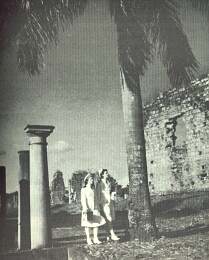 Off-duty excursion in the Canal
Zone
Off-duty excursion in the Canal
Zone
|
..... |
Navy Nurses had the chance to see many parts
of the world. Traveling was very expensive at that time and usually was
reserved for well-off people only. The service in the Navy Nurse Corps
offered attractive opportunities to see foreign countries and to become
acquainted with other cultures. Especially, some of the South Pacific Islands
where the Navy kept advanced bases were well known for their exotic beauty.
During the off-duty time, nurses had the possibility for sightseeing. |
.
Many Nurses made unforgettable experiences.
In 1944, some Navy Nurses who served abroad the USS Refuge in the Mediterranean
area were invited to an audience with the Pope who was interested in their
work and met him personally for an interview.
.
About a hundred Navy Nurses were assigned
to the Royal Victoria hospital in Netley , England. This hospital was famous
because it boasted a cornerstone laid by Florence Nightingale.
Additionally, it was rumored that the hospital
housed a heartbroken ghost of a nurse from the Crimean war who had slept
while her lover died in one of the wards. The Navy Nurses assigned to this
hospital treated almost 8,000 D-Day invasion casualties up to September
1944. |
.... |
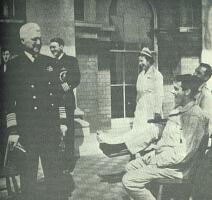 Admiral Stark visiting the orthopedic
patients in the Navy hospital at Netley on the English coast after
the invasion.
Admiral Stark visiting the orthopedic
patients in the Navy hospital at Netley on the English coast after
the invasion. |
.
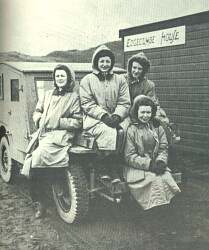 Navy Nurses in Adak (Alaska)
presenting Arctic fashions.
Navy Nurses in Adak (Alaska)
presenting Arctic fashions.
|
... |
One of the more difficult assignments was
duty in Alaska. The weather conditions which the nurses faced were extreme.
For example, in Adak the hospital was split up into several buildings scattered
over a large area. This measure should avoid that the whole hospital would
be destroyed at once. Therefore, the nurses had to walk long ways in cold
and stormy weather on muddy streets.
Often, they were the only women the soldiers
stationed there had seen for a long time and their appearance was most
appreciated. |
.
Some nurses had difficulties readjusting to
normal life in America after the end of their overseas duty. The nurses
sacrificed both youth and beauty to serve in far-off lands where the dangerous
conditions and diseases adversely affected their health and caused injuries.
Their overseas ordeals had created great hardship that civilian women never
faced and could not understand. Furthermore, they had to cope with all
the heavy injuries, suffering and dying they might have faced on duty.
At least, they knew that they did an important and courageous job. Their
work, often not very far away from the front lines, had saved many soldier's
lives.
.
.
Prisoners of War (POW)
.
Sixteen Navy Nurses who served in the Pacific
were taken prisoners of war during World War II. Fortunately, all of them
survived the imprisonment despite the often life-threatening conditions.
.
Captured in Guam
.
On 10 December 1941, the first five Navy Nurses
were captured on the Island of Guam in the Marianas Islands. In early 1942,
they were transported on the Japanese ship Argentina Maru and taken
to the Prisoner-of-War-Camp in Zentsuji, Japan. In March 1942, the nurses
were transferred to Kobe by ship and interned at an old hotel. There, the
conditions were fortunately a little better than endured in the camp. During
the time of imprisonment the nurses helped sick and wounded internees whenever
they could.
Eventually, the 5 Navy Nurses were freed in
a diplomatic exchange of prisoners of war. They left Japan in the end of
June. One Navy Nurse married a foreign service officer during the return
trip and followed him to his new service destination. On 24 August 1942,
the other four nurses arrived back in New York.
.
POW for thirty-seven months
.
| On 1 January of 1942, Manila in the Philippines
Islands was conquered by the Japanese. The 11 Navy Nurses stationed there
were taken prisoners of war on the next day. On 8 March, they were interned
at the Santo Tomas civilian internment camp in Manila together with about
3540 other internees. The nurses worked in the camp hospital and were supported
by additional Army Nurses who became interned in July 1942. The life in
the camp became more and more strenuous and difficult with more and more
prisoners added. The illness and hardship increased. |
.. |
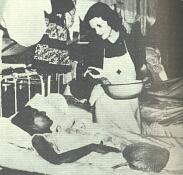
This picture of Lt. Margaret Nash
taken in the Santa Tomas prison camp was found on a Japanese prisoner during
the invasion of Leyte and was the first indication that Miss Nash and the
other Navy Nurses might be alive. |
.
When a new Internment Camp was set up at Los
Banos, all Navy Nurses together with one British nurse and a Filipino nurse
volunteered to go there. At Los Banos, the nurses improvised a camp hospital
that started with practically no equipment and supplies. Some of the prisoners
were trained by the nurses to help them. The prisoners had to life in constant
fear for their lives. Especially, the starvation became more and more serious
during the last months of interment.
.
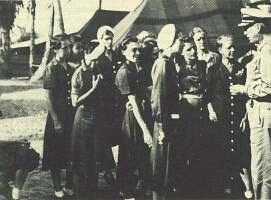
Navy Nurses, POW, just released
from Los Banos Prison Camp, Philippine Islands. |
.. |
On 23 February 1945, the over 2000 internees
at Los Banos were freed in a hazardous mission by ranger forces of the
Army. Since the internment camp was some 24 miles behind the enemy lines,
the liberation was very risky.
.
However, it was necessary to act as soon as
possible because more and more prisoners died due to the lack of food and
medicine every day. After 37 months of hunger and fear, all 11 Navy Nurses
were saved. |
On 4 September 1945, these 11 Navy Nurses
were awarded with the Bronze Star Medal by the U.S. Army “ for meritorious
achievement, while in the hands of the enemy, in caring for the sick and
wounded.”. In addition, the Navy awarded them a Gold Star in lieu of a
second Bronze Star Medal on the same day. Further rewards were the Army
Distinguished Unit Badge for the Unit of Nurses who had served at the Canacao
Hospital, the American Defense Service Ribbon with star, the Pacific and
Asiatic Service Ribbon with two stars, the Philippine Defense Ribbon with
one star and the Philippine Liberation Ribbon with one star.
.
Picture on the right:
Return of the POWs. From top to
bottom: Goldia O'Haver,
Eldene Paige, Dorothy Still, Mary
Rose Harrington, Mary
Chapman, Edwina Todd, Susie
Pitcher, Margaret Nash, Bertha
Evans, Helen Gorzelanski,
Laura Cobb. |
.. |
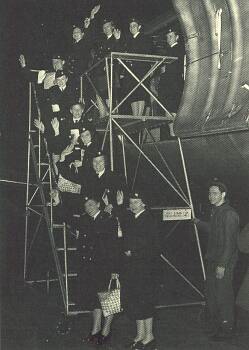 |
.
Hazardous Escape
.
One Navy Nurse, Ann Bernatitis, was able to
escape Japanese imprisonment in a hazardous escape. At first, she was stationed
with 11 Navy Nurses at Canacao, Philippines Islands. All twelve nurses
were evacuated to Manila shortly before the enemy invasion in December
1941. While the other nurses stayed in Manila (and were captured by Japanese
in January 1942 - as described above), Ann Bernatitis was ordered to a
field hospital in Bataan, at the end of 1941. There, she was part of a
Navy operating unit with the Army. At the end of March, the Japanese started
to attack Bataan. Two days before Bataan fell, the one Navy Nurse and eleven
Army Nurses stationed at Bataan were evacuated to Corregidor. At the beginning
of May, Corregidor was attacked by Japanese as well. On 3 May 1942, only
two days before Corregidor fell to the Japanese, the nurses were rescued
in a dangerous night escape from the island by the submarine USS Spearfish.
They arrived safe in Fremantle, Australia on the 20th of May.
.
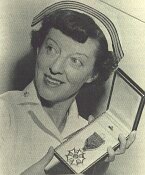 Commander Ann Bernatitis presenting
her Legion of Merit Medal
Commander Ann Bernatitis presenting
her Legion of Merit Medal
|
.. |
After Ms. Bernatitis return to America, she
went back to nurse duty. Furthermore, she was assigned to additional public
relation work to tell her adventurous story of the escape and encourage
more nurses to join the Navy Nurse Corps through her courageous example.
Ann Bernatitis later was awarded with the Legion of Merit Medal, the first
Legion of Merit Medal awarded to anyone. |
.
.
[ I. Development ]..[
II. Facts about the NNC ]..[
III. Uniforms ]..[
IV.
Sources
]
|
